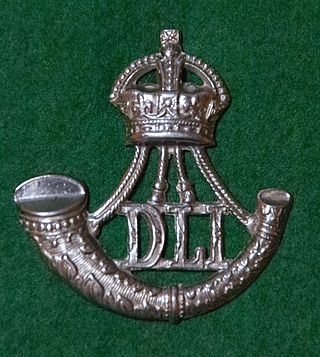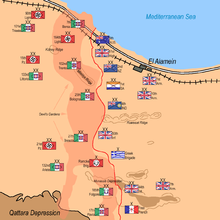
XXX Corps was a corps of the British Army during the Second World War. The corps was formed in the Western Desert in September 1941. It provided extensive service in the North African Campaign and many of its units were in action at the Second Battle of El Alamein in late 1942. It then took part in the Tunisia Campaign and formed the left flank during the Allied invasion of Sicily in 1943.
The 1st South African Infantry Division was an infantry division of the army of the Union of South Africa. During World War II the division served in East Africa from 1940 to 1941 and in the Western Desert Campaign from 1941 to 1942. The division was disbanded on 1 January 1943, for conversion into what would become the 6th South African Armoured Division. The division was also briefly active after the war from 1 July 1948 to 1 November 1949.

The Northumbrian Division was an infantry division of the British Army, formed in 1908 as part of the Territorial Force with units drawn from the north-east of England, notably Northumberland, Durham and the North and East Ridings of Yorkshire. The division was numbered as 50th (Northumbrian) Division in 1915 and served on the Western Front throughout the First World War. Due to losses suffered in the Ludendorf Offensive in March 1918 it had to be comprehensively reorganized. It was once again reformed in the Territorial Army as the Northumbrian Division in 1920.

The Durham Light Infantry (DLI) was a light infantry regiment of the British Army in existence from 1881 to 1968. It was formed in 1881 under the Childers Reforms by the amalgamation of the 68th (Durham) Regiment of Foot and the 106th Regiment of Foot along with the Militia and Volunteers of County Durham.

The 50th (Northumbrian) Infantry Division was an infantry division of the British Army that saw distinguished service in the Second World War. Pre-war, the division was part of the Territorial Army (TA) and the two Ts in the divisional insignia represent the two main rivers of its recruitment area, namely the rivers Tyne, and Tees. The division served in almost all of the major engagements of the European War from 1940 until late 1944 and also served with distinction in North Africa, the Mediterranean and Middle East from mid-1941 to 1943. The 50th Division was one of two British divisions to land in Normandy on D-Day, 6 June 1944, where it landed on Gold Beach. Four men of the division were awarded the Victoria Cross during the war, more than any other division of the British Army during the Second World War.
The 150th Infantry Brigade was an infantry formation of the British Army that saw active service in the Second World War. A 1st Line Territorial Army brigade, it was part of the 50th (Northumbrian) Infantry Division. It served in the Battle of France and was evacuated from Dunkirk. Later it served in the Middle East and was overrun and forced to surrender during the Battle of Gazala in the North African Campaign. For almost 72 hours during the battle the 150th Brigade and the 44th Royal Tank Regiment held out against Erwin Rommel's concentrated attacks, without any support. On 1 June the German Army finally forced their surrender. The brigade was not reformed.
The 22nd Guards Brigade was an infantry brigade of the British Army that saw distinguished active service during the Second World War.

The 22nd Armoured Brigade was an armoured brigade of the British Army that saw service during and after the Second World War. The brigade was formed on the outbreak of war on 3 September 1939 from Territorial Army (TA) armoured regiments. It saw a considerable amount of action during the war, beginning with the Western Desert Campaign where it was engaged in Operation Crusader and at the Battles of Gazala, Mersa Matruh, First Alamein and Alam el Halfa. It then joined the 7th Armoured Division for the Second Battle of El Alamein. It remained part of 7th Armoured for the rest of the war, including the campaigns in Tunisia, Italy and North West Europe. It continued in the postwar TA until 1956. The brigade's identity was re-established in the Regular Army between 1981 and 1993.
The 69th Infantry Brigade was an infantry brigade of the British Army in the Second World War. It was a second-line Territorial Army formation, and fought in the Battle of France with the 23rd (Northumbrian) Division. The brigade was later part of the 50th (Northumbrian) Infantry Division. It went on to fight in the North African campaign, the Allied invasion of Sicily, the Normandy landings and the North West Europe campaign.

The 8th Armoured Brigade was an armoured brigade of the British Army formed in August 1941, during the Second World War and active until 1956. The brigade was formed by the renaming of 6th Cavalry Brigade, when the 1st Cavalry Division based in Palestine converted from a motorised formation to an armoured unit, becoming 10th Armoured Division.

The 23rd (Northumbrian) Division was an infantry division of the British Army, which fought briefly in the Battle of France during the Second World War. In March 1939, after the re-emergence of Germany as a European power and its occupation of Czechoslovakia, the British Army increased the number of divisions within the Territorial Army by duplicating existing units. The 23rd (Northumbrian) Division was formed in October 1939, as a second-line duplicate of the 50th (Northumbrian) Motor Division. It was made up of two brigades, unlike regular infantry divisions that were composed of three, with battalions hailing from the north of England.
The 70th Infantry Brigade was an infantry brigade of the British Army that saw service during both the First and Second World War and postwar.

The Battle of Mersa Matruh was fought from 26 to 29 June 1942, following the defeat of the Eighth Army at the Battle of Gazala and was part of the Western Desert Campaign of the Second World War. The battle was fought with the German–Italian Panzer Army Afrika (Panzerarmee Afrika. The Eighth Army comprised X Corps and XIII Corps.

The 102nd Motorized Division "Trento" was a motorized infantry division of the Royal Italian Army during World War II. The division was formed in 1935 and named for the city of Trento, where its infantry and artillery regiments were based. The Trento served in the Western Desert Campaign and was destroyed in the Second Battle of El Alamein in November 1942.
205 Battery Royal Artillery is part of the 101st (Northumbrian) Regiment Royal Artillery and is equipped with the M270 Multiple Launch Rocket System. It is based in South Shields, United Kingdom.
The Durham Light Infantry Brigade was formed in 1902 to command the part-time Volunteer battalions of the Durham Light Infantry (DLI). Previously these had been in a combined Tyne and Tees Brigade with battalions of the Northumberland Fusiliers. It consisted of the 1st–4th Volunteer Battalions of the DLI, which were renumbered as the 5th–8th Battalions when the Volunteers were subsumed into the Territorial Force (TF) under the Haldane Reforms of 1908. Consisting of 6th–9th Battalions, it became part of the TF's Northumbrian Division. During World War I it was numbered as the 151st Brigade on 14 May 1915, when the division became the 50th (Northumbrian) Division. The TF also raised 2nd Line units and formations, and the 190th Brigade was formed in 63rd Division. The 1st Line battalions adopted the prefix '1/'
The 190th Brigade was a 2nd Line Territorial Force formation of the British Army during World War I. Formed from battalions of the Durham Light Infantry, it served in home defence without ever going overseas as a complete formation.
The Sunderland Rifles was a Volunteer unit of the British Army formed in 1860. It went on to become a Battalion of the Durham Light Infantry (DLI) in the Territorial Force and saw action as infantry and pioneers in some of the bloodiest actions on the Western Front during World War I. Between the wars it became an air defence unit, serving during World War II in The Blitz and the campaign in North West Europe, when it had a special role in the Rhine crossing. Postwar it continued in the Territorial Army in the air defence role until 1975, when its successor unit reverted to infantry.
The 1st Durham Rifle Volunteers, later the 5th Battalion, Durham Light Infantry, was a part-time unit of the British Army from 1860 to the 1950s. Beginning from small independent corps of the Volunteer Force recruited in County Durham and Teesside, it became part of the Territorial Force and served as infantry in some of the bloodiest actions of the First World War. Later it was converted to anti-aircraft units that served during the Second World War both in Home Defence and in North-West Europe. Its successor units continued in the air defence role in the postwar Territorial Army until 1975.

The Hull Rifles, later the 4th Battalion, East Yorkshire Regiment, was a unit of Britain's Volunteer Force first raised in Kingston upon Hull in 1859. During the First World War it served on the Western front, seeing a great deal of action at Ypres, the Somme, Arras, and in the German spring offensive, when it was virtually destroyed. Its 2nd Line battalion garrisoned Bermuda for much of the war. During the Second World War the 4th Battalion was captured at the Battle of Gazala, but its wartime duplicate unit fought on through the Western Desert, Tunisia and Sicily, and then landed in Normandy on D Day. The battalion served in the postwar Territorial Army until 1960, and its successors in today's Army Reserve continue in Hull.

















